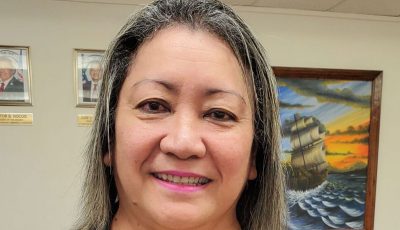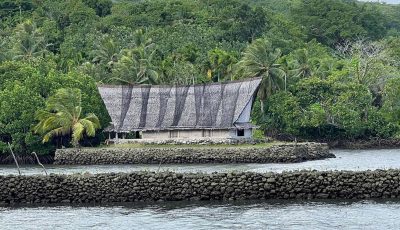Our reefs: Mostly dead
Do some of you may remember the movie The Princess Bride? During the last third of the movie, the main male character, Westley, thought to be dead, is brought to Miracle Max the Healer, played by Billy Crystal. After examining his new patient, he’s asked if the man is, in fact, dead. Billy responds, “No, he’s just mostly dead.”
And that’s the condition of our reefs today—mostly dead. But you already knew that, didn’t you? No, probably not. I’m not sure why this fact is being kept quiet by the Coastal Resource Management’s director and staff. I spoke to our lead reef scientist and she concurred—our reefs are mostly dead. I asked “Why?” Her response began with “Over-fishing is one reason…but I’m not allowed to use that word.” Well, over-fishing is one reason. Yeah, talk to our fishermen. They’ll tell you that they have to go out further and deeper to get decent sized fish and the rest are taken just because they’re alive, even though they’re immature and should be left alone.
There are other reasons. Back in the old days, people had an outhouse or just a pit or simply a nearby jungle for their sewage. And that flowed into the small creeks and, when it rained, that sewage flowed out into our reefs. We still have this practice and that’s why we have our beaches “red flagged.” It’s got to stop. When you live on a little island with 70-, 80-, or 90,000 people, there’s no longer room for this “ancient custom.” Those households must be connected to the CUC sewer system and CUC needs to upgrade that system in both the number of treatment sites and the level of treatment—what is it now? Level One? It should be Tertiary! Even Secondary is unacceptable on our small islands.
There wasn’t the use of pesticides and herbicides that make their way into our reefs. There wasn’t the level of ground disturbance (translate: “development”) that results in fine earth (silts) making their way into our reefs.
But what about those CW’s who came 20 to 25 years ago and started using household bleach on the corals to stun or kill the marine life but killed our corals in the process? They did it in their home country, why not here? Some are still doing this. Man, if you see someone doing this now, nail their asses! It’s bad for everyone, illegal, and they know it…that’s why they’re still doing it but often at night.
It’s true, there has been a shift in temperatures that’s been harmful to our reefs, to our corals. And we have knuckleheads for tourists…most have never in their lives been around water that is clear no less reefs with clear water. China’s waters—whether streams, rivers, lakes, or oceans/seas—are incredibly polluted. They’re glad to snorkel Managaha but few would know what a healthy reef looks like if they ever saw one—and it won’t be here! It was only a few months ago that they thought the Grotto was a terrific urinal, ashtray, and trash can! Self-flushing, self-emptying!
I was talking to the chief of one of our nation’s top Search, Rescue, & Recovery Teams (in Hawaii) and he said that one of the best indicators of a dying or dead reef is the lack of large predators. We probably think that not having large sharks in our reefs is good for tourism. But did you ever think that not having them around is a sign that we’re in trouble? The Chinese scuba guides that were luring tiger sharks into LauLau Bay, the centuries-old site of families safely swimming for lack of sharks, was being threatened by people who wanted their pictures taken with these deadly predators close by. This activity does not count toward the restoration of a reef.
Matt Smith, the attorney who recently died and who I miss, has an older son who was largely responsible for the great mural we have on the wall at the AMP tennis court (and thank you all for not damaging it). On the mural are these words, “The Reef is our Future.” It is. They are. But if I want to go see beautiful, healthy reefs, I’ll go to Palau or Pohnpei, not Saipan. If I can figure that out, so can most others including our tourists.
But our reefs are more than tourist attractions—they reflect our health. They were once the source of healthy fish for our families. Our salt came from boiled or sun-dried reef water. They were a source of exercise found in swimming, fishing, and canoeing. They were also a source of positive education and inspiration…it’s why people buy land with a view of the reefs! It’s the reason why hotels, resorts, and restaurants want to be on the beach.
So, the reefs are almost dead. So what? What do we do? Everybody dies, right? It just happens. And life goes on. But the reefs aren’t like someone dying. They’re like having all the Chamorros of the world dying at the same time. Or all the Carolinians of the world dying. We would all feel that impact. It’s like the death of a civilization that is very difficult to recover from. The same with the reefs. So what do we do?
We have had a lot of scientists come here to study aspects of our reefs for their benefit. It’s time we have a reef scientist come here to assess what’s wrong and recommend what’s to be done for our benefit. I think that we should bring in Thomas Goreau and his little team. Why Tom? Well, he’s the No. 1 reef scientist in the world. He’s spent more time in the water than any other reef scientist. He’s studied more reefs around the world than any reef scientist. He loves our reefs. He knows their general condition and would like to help us. You see, back in 1969 his father and brother surveyed all of Saipan’s reefs, sometimes holding on to a rope pulled by a boat with an outboard. They discovered that our reefs were being destroyed by the crown of thorns starfish, which eat coral at a devastating rate (the COT missed LauLau Bay because of the wave action at each end). Tom returned 30 years later (1999) with his brother and they re-surveyed the reefs. Staghorn corals are an indicator of good reef health—they found only one, small-sized group-specimen just off the beach of Tanapag in one foot of water. One. And things have not gotten better. And, finally and frankly, he’s not that expensive—certainly not for what he can offer us.
Tom and his team need to be brought over to assess the reefs of Saipan, Tinian, and Rota—and the sooner, the better. Now would be a good time. Then his team will write up their findings and indicate what steps they feel must be taken to return the reefs to health. I’m telling you (please, hear me out): Reefs are dying all around the world and the so-called scientists are doing little more that studying them as they die. If you were dying at CHC, would you be content with young pups from some university simply studying your decline? Or would you like an experienced doctor to diagnose the cause of your decline and make specific recommendation as to what steps can be taken to change the course of your condition for the better? Then you decide if you want to die or want to start that course of action recommended by this experienced doctor.
It’s important to mention that Tom has a patent that leads to growing corals five times their normal rate! And the results are corals that are 5,000 percent more resistant to the surface temperature warming that causes coral bleaching than that of normal corals.
This is interesting: Did you know that Tom and team where under contract with a U.S. Navy contractor to assess the damage done from work on the Navy harbor in Guam? This would have been the first time the military had ever taken this step—to have a truly outside evaluation done regarding reef damage. But just days before they were to start, the contract was canceled. Makes you wonder about the integrity of the military’s assessments of Tinian’s and Pagan’s use and the damage to be incurred in those places in the future.
But what about our integrity now? We’re to be good stewards of the reefs and ocean. We claim that they’re ours. The legal issue is one thing. Now let’s take care of them. Let’s take the first positive step in that direction in recent history and urge the director of the Division of Coastal Resource Management, Ms. Fran Castro (664-8525, frances@crm.gov.mp) and her boss, the administrator of the Bureau of Environmental and Coastal Quality, Mr. Frank Rabauliman (664-8550, frabauliman@gmail.com), to bring Tom and his team over.
If you would like a more detailed description of Tom’s credentials, please send me a note at liddlega@yahoo.com and I’ll accommodate you as soon as I can. Thank you for considering what is negatively impacting you and me far more than we realize—the slow death of our reefs. Let’s leave a legacy for our kids, grandkids, and others to be proud of and who can benefit from what we’ve done.
P.S.: Tourists don’t need more signs…they don’t read the ones that already exist. How about a display of a coral head at the baggage claim area at each of our airports that invites them (while they’re waiting for their luggage to arrive) to come and touch it. Then they can read a paragraph that explains that touching or standing on live corals will kill them and to please don’t.
And we have tons of tourists out at Managaha snorkeling who stand on the corals when they need to rest or socialize, talking about what they’ve just seen. Let’s give them an alternative rather than just tell them not to stand on the coral. Let’s place stools made of plastic, weighted with concrete rings, located strategically on the sandy bottom as that alternative. They can sit or stand on these stools instead of the corals. Please be advised: I’ve been told that hiring a retired Army sniper is not an allowable option.
Also consider:
Legal requirement for tourist businesses to use:
1. Floating fins (non-floating fins sink and, from the wave action, damage the corals as does kicking the corals with your fins when swimming).
2. Foam ring anklets to discourage vertical positioning.
3. Noodles for snorkelers with Velcro wrist straps on coil cords to prevent the noodles from floating away. Gary A. Liddle (Special to the Saipan Tribune)
Gary A Liddle is proprietor of Liddle Mesa Enterprises, Lodestar Learning Center, Micronesia Innovations & Development, and Micronesia Business Accelerator. He may be contacted at liddlega@yahoo.com.



























